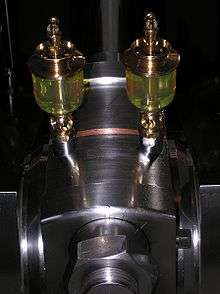Crankpin

Crankpins highlighted in blue

A crank pin of a ship steam engine with the lubricating system visible
In a reciprocating engine, the crankpins, also known as crank journals are the journals of the big end bearings, at the ends of the connecting rods opposite to the pistons.
If the engine has a crankshaft, then the crank pins are the journals of the off-centre bearings of the crankshaft. In a beam engine, the single crank pin is mounted on the flywheel; In a steam locomotive, the crank pins are often mounted directly on the driving wheels.
Big end bearings
Big end bearings are commonly bushings or plain bearings, but less commonly may be roller bearings, see crankshaft.
In a multi-cylinder engine, a crankpin can serve one or many cylinders, for example:
- In a straight (parallel) or flat (boxer) engine, each crankpin normally serves just one cylinder.
- In a V engine, each crankpin usually serves two cylinders, one in each cylinder bank.
- In a radial engine, each crankpin serves an entire row of cylinders.
Big end design
There are three common configurations of big end bearing:
- If a crankpin serves only one cylinder, then the big end is a relatively simple design, accommodating only one connecting rod. This design is the cheapest to produce, and is used in:
- All single-cylinder engines.
- Most straight engines.
- All boxer engines.
- Some V-twin engines.
- If a crankpin serves more than one cylinder, then the corresponding cylinders may have an offset, to simplify the design of the big end bearing. This design is used in:
- Most V engines.
- Multiple row radial engines.
- If more than one cylinder is served by a single crankpin but there is no offset, then some or all of the connecting rods must be forked at the big end. This design provides better engine balance than designs with an offset, but requires extra complexity and cost in both design and manufacture, and more weight or closer manufacturing tolerances to achieve the same strength and reliability. Any extra weight added to the big end itself also carries a penalty of adding vibration and reducing balance. As the number of cylinders grows, the effect of the offset on balance becomes less important, and forked connecting rods become less common. They are mainly used in:
- Single-row radial engines.
- Some V-twin engines, notably including motorcycle engines.
See also
References
This article is issued from Wikipedia - version of the 11/24/2015. The text is available under the Creative Commons Attribution/Share Alike but additional terms may apply for the media files.